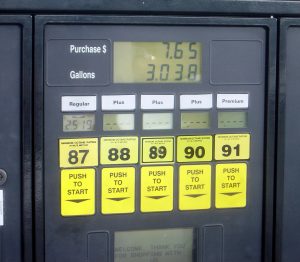 Today, the Sabin Center published a new working paper discussing the possibility of federal and/or state regulation to increase fuel octane levels. Many readers may be wondering: what is octane? And why do we want to increase it? In simple terms, octane is a measure of a fuel’s ability to withstand compression in a vehicle engine, without self-igniting. Most fuel sold in the U.S. has a low octane rating, meaning that it is prone to self-ignition when compressed, and thus can only be used in low-compression engines. Those engines are extremely inefficient and emit significant carbon dioxide. It’s not surprising then that transportation is the second largest source of carbon dioxide in the U.S., accounting for a massive 31 percent of national emissions in 2014 according to the Environmental Protection Agency (“EPA”).
Today, the Sabin Center published a new working paper discussing the possibility of federal and/or state regulation to increase fuel octane levels. Many readers may be wondering: what is octane? And why do we want to increase it? In simple terms, octane is a measure of a fuel’s ability to withstand compression in a vehicle engine, without self-igniting. Most fuel sold in the U.S. has a low octane rating, meaning that it is prone to self-ignition when compressed, and thus can only be used in low-compression engines. Those engines are extremely inefficient and emit significant carbon dioxide. It’s not surprising then that transportation is the second largest source of carbon dioxide in the U.S., accounting for a massive 31 percent of national emissions in 2014 according to the Environmental Protection Agency (“EPA”).
Carbon dioxide emissions could be reduced by increasing engine compression ratios. In high compression ratio engines, fuel is subjected to greater pressure in the combustion chamber and therefore burns more completely, producing more power with fewer emissions. Despite these benefits, however, high compression engines are not widely used in the U.S. This is primarily due to concerns over the potential for high compression engines to experience knock, an abnormal combustion phenomenon wherein fuel self-ignites and explodes, resulting in an increase in pressure which can damage the engine and reduce vehicle efficiency. To avoid knock, high compression engines must use premium, high octane fuel. A 2014 study by researchers at the Massachusetts Institute of Technology found that switching to premium fuel would enable the deployment of high compression engines which are 2 to 5 percent more fuel efficient than current models.
Several vehicle manufacturers and other industry participants have recently called on the EPA to adopt regulations to increase fuel octane levels. While EPA officials have previously expressed support for regulation, it is unclear whether action will be taken by the next administration. In the absence of federal action, states may wish to adopt their own regulations. Our paper explores the legal basis for regulating octane at the federal and/or state levels. We find that primary regulatory authority rests with the EPA under section 211 of the Clean Air Act. The section pre-empts state regulation where the EPA has regulated a fuel or found regulatory action to be unnecessary. There is, however, an exception for California which may adopt its own fuel regulations regardless of any action by the EPA. Regulations adopted by California are not subject to review and/or approval by the EPA. The regulations only apply in California and cannot be adopted by other states, in preference to federal regulations, as is permitted with respect to vehicle emission standards.
Under section 211 of the Clean Air Act, the EPA could regulate octane if evidence before it demonstrates that switching to high octane fuel is necessary to achieve vehicle carbon dioxide emissions standards (i.e., adopted under section 202 of the Act) or would significantly reduce the costs of achieving those standards. If the EPA fails to act, state agencies may regulate octane, provided that EPA has not published a finding, indicating that such regulation is unnecessary. Even if EPA makes such a finding, however, regulations could be adopted by California. We recommend that California specify a minimum octane rating for all fuel sold in the state. This would facilitate the deployment of more efficient, high compression engines in vehicles used in California. To ensure those vehicles can be refueled in other states, the octane rating specified by California should not exceed that of premium fuel, available across the U.S. Use of such fuel would not impair the operation of existing vehicles and would enable significant efficiency improvements in new vehicles.



